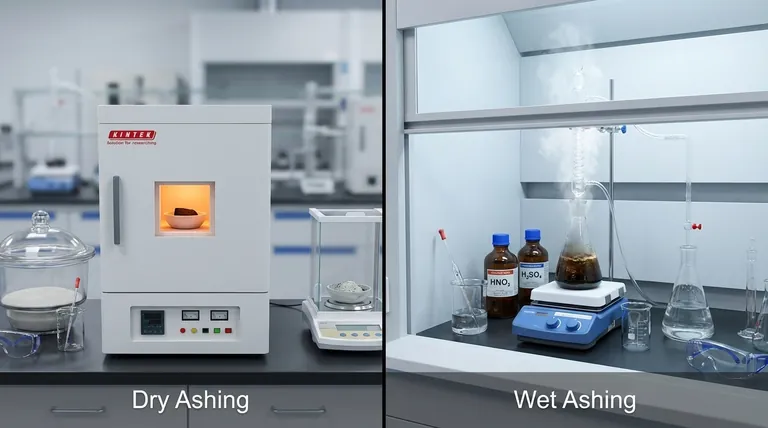Dry ashing and wet ashing (or wet digestion) are two distinct analytical techniques used to prepare samples for further analysis, particularly in determining the inorganic composition of organic materials. Dry ashing involves heating a dry sample at high temperatures (around 500-600°C) in a muffle furnace to oxidize organic matter and leave behind inorganic residues like oxides, sulfates, and phosphates. Wet ashing, on the other hand, uses strong acids and oxidizing agents in an aqueous solution to decompose organic matter at lower temperatures, leaving mineral oxides in the solution. While dry ashing is simpler and requires less equipment, it can be less accurate due to the potential loss of volatile compounds. Wet ashing offers greater precision and control over the decomposition process but is more complex and time-consuming. The choice between the two methods depends on the sample type, the elements being analyzed, and the required accuracy.

Key Points Explained:
-
Definition and Process:
- Dry Ashing: This method involves heating a dry sample in a muffle furnace at high temperatures (typically 500-600°C) to combust organic matter and leave behind inorganic residues such as oxides, sulfates, and phosphates.
- Wet Ashing (Wet Digestion): This technique involves heating a sample in an aqueous solution with strong acids (e.g., nitric acid, sulfuric acid) and oxidizing agents to decompose organic matter at lower temperatures, leaving mineral oxides in the solution.
-
Sample State:
- Dry Ashing: The sample is in a dry state, making it suitable for solid materials like food, soil, or ash.
- Wet Ashing: The sample is in an aqueous state, which is ideal for liquid samples or samples that need to be dissolved in acid.
-
Temperature and Equipment:
- Dry Ashing: Requires a muffle furnace and operates at high temperatures (500-600°C). The process is relatively simple but may lead to the loss of volatile compounds.
- Wet Ashing: Operates at lower temperatures and does not require a muffle furnace. The temperature and time depend on the type and strength of the acids and oxidizing agents used, offering greater control over the decomposition process.
-
Accuracy and Precision:
- Dry Ashing: Less accurate due to the potential loss of volatile materials during the high-temperature process.
- Wet Ashing: More precise as it minimizes the loss of volatile compounds and allows for better control over the decomposition of organic matter.
-
Applications:
- Dry Ashing: Commonly used for samples where high-temperature oxidation is acceptable, such as in food analysis, soil testing, and ash content determination.
- Wet Ashing: Preferred for samples requiring precise decomposition of organic matter, such as in environmental analysis, biological samples, and trace metal analysis.
-
Advantages and Disadvantages:
-
Dry Ashing:
- Advantages: Simple, requires less equipment, and is cost-effective for large-scale analysis.
- Disadvantages: Potential loss of volatile compounds, less accurate for certain elements.
-
Wet Ashing:
- Advantages: Greater precision, better control over decomposition, and suitable for a wider range of samples.
- Disadvantages: More complex, time-consuming, and requires handling of hazardous chemicals.
-
Dry Ashing:
-
Standards and Guidelines:
- Both methods may be governed by international standards such as ISO, EN, or ASTM, ensuring consistency and reliability in analytical results. For example, dry ashing is often used in Loss on Ignition (LOI) tests, where samples are weighed before and after ashing to determine mass reduction.
-
Volatility and Residue:
- Dry Ashing: May result in the loss of volatile elements (e.g., mercury, arsenic) due to high temperatures, leaving behind non-volatile residues like metal oxides.
- Wet Ashing: Minimizes the loss of volatile elements, as the process occurs at lower temperatures, and the residues remain in the solution for further analysis.
In summary, the choice between dry ashing and wet ashing depends on the nature of the sample, the elements being analyzed, and the required accuracy. Dry ashing is simpler and more cost-effective but may compromise accuracy for volatile elements. Wet ashing, while more complex, offers greater precision and control, making it suitable for a wider range of applications.
Summary Table:
| Aspect | Dry Ashing | Wet Ashing |
|---|---|---|
| Process | High-temperature oxidation in a muffle furnace (500-600°C) | Decomposition using strong acids and oxidizing agents at lower temperatures |
| Sample State | Dry (solid materials like food, soil, ash) | Aqueous (liquid samples or samples dissolved in acid) |
| Temperature | High (500-600°C) | Lower (depends on acids and oxidizing agents) |
| Accuracy | Less accurate due to potential loss of volatile compounds | More precise, minimizes loss of volatile compounds |
| Applications | Food analysis, soil testing, ash content determination | Environmental analysis, biological samples, trace metal analysis |
| Advantages | Simple, cost-effective, requires less equipment | Greater precision, better control, suitable for a wider range of samples |
| Disadvantages | Loss of volatile compounds, less accurate for certain elements | Complex, time-consuming, requires handling hazardous chemicals |
Need help choosing the right ashing method for your analysis? Contact our experts today for personalized guidance!
Visual Guide

Related Products
- 1400℃ Muffle Oven Furnace for Laboratory
- 1700℃ Muffle Oven Furnace for Laboratory
- Laboratory Muffle Oven Furnace Bottom Lifting Muffle Furnace
- 1800℃ Muffle Oven Furnace for Laboratory
- 1400℃ Laboratory Quartz Tube Furnace with Alumina Tube Tubular Furnace
People Also Ask
- How is the ash content determined in a muffle furnace? Master the Gravimetric Analysis Method
- How accurate is the muffle furnace? Achieve ±1°C Control and ±2°C Uniformity
- What is done by ashing in muffle furnace? A Guide to Precise Inorganic Content Analysis
- What is the difference between a box furnace and a muffle furnace? Choose the Right Lab Furnace for Your Application
- How do you control a muffle furnace? Master Precise Temperature Control for Your Lab



















